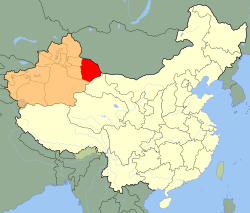Kumul Khanate قۇمۇل خانلىقى 哈密札薩克旗 | |||||||||
|---|---|---|---|---|---|---|---|---|---|
| 1696–1930 | |||||||||
 Hami prefecture (red), location of the Kumul Khanate, in Xinjiang (orange) (modern borders shown) | |||||||||
| Status | Banner of the Qing dynasty (1696–1912)[1] Vassal of the Republic of China (1912–1930) | ||||||||
| Capital | Kumul, Xinjiang | ||||||||
| Common languages | Chinese language, Chagatai language (predecessor of Turki Uyghur)[2] | ||||||||
| Religion | Sunni Islam | ||||||||
| Demonym(s) | Kumulik | ||||||||
| Government | Monarchy | ||||||||
| Khan | |||||||||
• 1867–1882 | Muhammad Shah | ||||||||
• 1882–1930 | Maqsud Shah (last) | ||||||||
| Chancellor/Baig[3] | |||||||||
• 1922–1930 | Yulbars Khan (last) | ||||||||
| History | |||||||||
• Established | 1696 | ||||||||
| 1930 | |||||||||
| Currency | Xinjiang coins | ||||||||
| |||||||||
| Today part of | China | ||||||||
The Kumul Khanate was a semi-autonomous feudal Turco-Mongol khanate (equivalent to a banner in Mongolia[4]) within the Qing dynasty and then the Republic of China until it was abolished by Xinjiang governor Jin Shuren in 1930. The khanate was located in present-day Hami prefecture of Xinjiang.
- ^ 王希隆; 杨代成, eds. (2018). "清顺康雍三朝对天山以南地方政权与地方势力政策述评1 ———以叶尔羌、哈密、吐鲁番与清朝的互动关系为中心" [A Review of the Policies of Emperor Shunzhi,Kangxi and Yongzheng of the Qing Dynasty towards the Local Authorities and Powers in the South of Tianshan Mountains] (PDF). CASS.
接受招抚的哈密、吐鲁番土著首领额贝都拉、额敏和卓先后各率近万名部属投归清朝,被编设为两个札萨克旗
- ^ "Chagatai literature". Encyclopedia Britannica. Retrieved 2021-09-19.
- ^ "Political System". History Research Society of Qing Dynasty in Singapore. 14 October 2012.
- ^ 达远, 黄. "试论清代哈密回旗". 新疆大学中亚文化研究所.